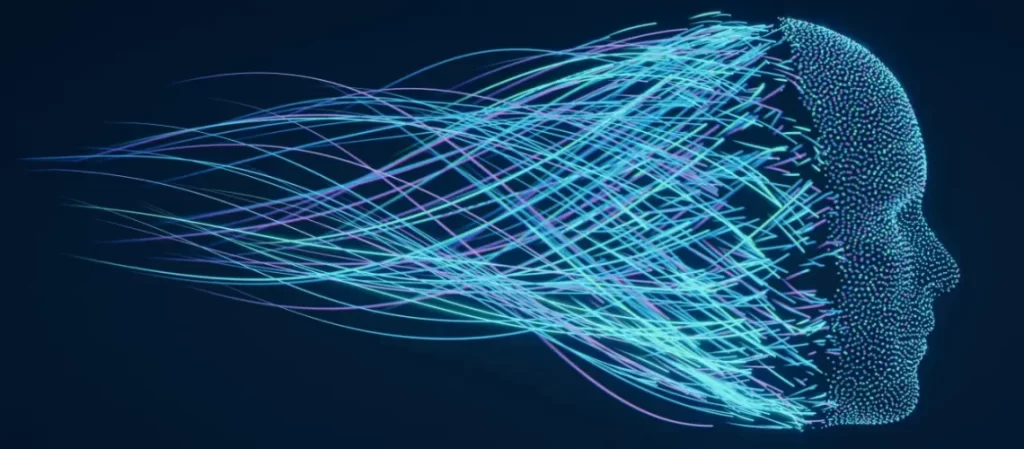Deep learning, in its simplest terms, is a type of computer technology that tries to make computers think and learn like the human brain. It involves using computer programs called artificial neural networks to process information and make decisions in a way that resembles how our brains work. These networks have many layers of interconnected parts, allowing them to understand and learn from complex data, such as images, text, and sound, without needing direct instructions from humans.
Deep learning has been used to solve challenging problems like recognizing objects in photos, understanding spoken language, and even playing complex games, making it a powerful tool in the field of artificial intelligence.
Machine Learning

Machine learning is a subfield of computer technology a.k.a artificial intelligence (AI) that allows computers to learn and make predictions or decisions without being explicitly programmed to do so.
Here’s a basic breakdown for Machine Learning:
- Data: You start with a bunch of data, like pictures of cats and dogs if you want the computer to distinguish between them.
- Training: You show this data to the computer and tell it which examples are cats and which are dogs. The computer learns from this by finding patterns and relationships in the data.
- Prediction: After training, the computer can use what it learned to make predictions. For example, it can look at a new picture and predict whether it’s a cat or a dog based on the patterns it has learned.
What does the Term ‘Deep Learning’ Mean?

Deep learning is a division of machine learning that involves training an Artificial Neural Network (ANN), that performs various machine learning tasks. In the simplest context, we are teaching a computer to mimic the human brain’s way of learning and solving problems.
How does Deep Learning function?

Here’s a basic explanation of how deep learning works:
- Neural Networks: Deep learning uses artificial neural networks, which are composed of layers of interconnected nodes (neurons). These networks are designed similar to the structure of the human brain.
- Data Input: You start by feeding a neural network a large amount of data. This data could be anything from images and text to numerical values.
- Learning: The neural network learns from the data through a process of trial and error. It adjusts the connections between its neurons to recognize patterns and relationships within the data.
- Deep Layers: What makes deep learning “deep” is the presence of multiple hidden layers in the neural network. These layers allow the network to learn increasingly complex and abstract features from the data.
- Training: During training, the network compares its predictions to the actual outcomes in the training data and adjusts its internal parameters (weights and biases) to reduce the error. This process is repeated many times until the network becomes good at making accurate predictions.
- Prediction: Once the network is trained, it can be used to make predictions or classifications on new, unseen data. For example, it can recognize objects in images, translate languages, or play games.
In essence, deep learning is about building complex mathematical models (neural networks) that can learn and represent patterns in data. It’s particularly powerful for tasks involving large amounts of data and complex relationships, such as image and Speech Recognition, Natural Language Processing (NPL), and Autonomous Driving.
Why is it Called Deep Learning?

Deep learning is called “deep” because it employs the use of artificial neural networks with multiple hidden layers between the input and output layers. The term “deep” refers to the depth of these networks, meaning they have many layers, which distinguishes them from shallow networks with fewer hidden layers.
The depth of the network is a key characteristic of deep learning and sets it apart from traditional machine learning methods that often use shallower models. The idea behind deep learning is to create more complex and hierarchical representations of data by allowing the network to learn increasingly abstract features as it processes information through these deep layers.
The use of deep neural networks has led to significant advancements in various fields, including computer vision, natural language processing, speech recognition, and more, as they are highly effective at capturing intricate patterns and representations in data. Hence, the name “deep learning” reflects the fundamental architectural feature of these neural networks, which is their depth.
How many layers does a neural network need to be considered “deep learning”?
In the context of deep learning, “depth” simply means the number of layers in a neural network. When we say a network is “deep,” it means it has more than just a couple of layers; it typically has several hidden layers between the input and output layers. However, there’s no specific number of layers that makes a network “deep.” Instead, it’s about having enough layers to learn complex patterns and representations from data. So, the more layers, the better a network can capture intricate details and make sense of complex information, like recognizing objects in images or understanding language. But, it’s also important to balance depth with computational resources and data availability.
Advantages of Deep Learning: Unlocking the Power of Neural Networks

Deep learning offers several advantages, which have contributed to its widespread adoption and success in various fields. Some of the key advantages include:
- High Accuracy: Deep learning models can achieve state-of-the-art performance on a wide range of tasks, including image recognition, natural language processing, and speech recognition. They are capable of learning complex patterns and representations from large datasets, leading to high accuracy in predictions and classifications.
- Feature Learning: Deep learning models can automatically learn relevant features from the data, eliminating the need for hand-crafted feature engineering. This makes them highly adaptable to different types of data and tasks.
- Hierarchical Representation: Deep neural networks can capture hierarchical representations of data, learning abstract features at different levels of depth. This ability to build increasingly complex abstractions is crucial for tasks that involve recognizing patterns within patterns.
- Scalability: Deep learning models can be scaled up to handle large datasets and complex problems. With advances in hardware and distributed computing, it’s possible to train deep networks on massive amounts of data, which can lead to improved performance.
- Transfer Learning: Pre-trained deep learning models, such as convolutional neural networks (CNNs) and pre-trained language models, can be fine-tuned for specific tasks. This transfer learning approach saves time and resources when developing new applications.
- Flexibility: Deep learning can be applied to a wide range of tasks, from image and speech recognition to natural language understanding and generation. It has shown versatility in solving problems across various domains.
- Automation: Once trained, deep learning models can make predictions or decisions autonomously, reducing the need for human intervention in repetitive tasks.
- Adaptability: Deep learning models can adapt to changing data distributions and evolving patterns, making them suitable for applications where the data environment is dynamic.
- State-of-the-Art Results: In many domains, deep learning has achieved results that were previously considered unattainable, such as surpassing human performance in image recognition and achieving human-level accuracy in language translation.
- Continuous Improvement: Research in deep learning is ongoing, leading to continuous advancements in architecture design, training techniques, and model optimization, which further enhances performance.
Applications of Deep Learning in Everyday Life

Deep learning is used in our daily lives in various ways. One relatable application is in the recommendation systems used by streaming platforms like Netflix or YouTube. When you see personalized movie or video recommendations, deep learning is at work. These systems analyze your past viewing habits, preferences, and even what other users with similar tastes have watched. Then, they use deep learning algorithms to suggest content you’re likely to enjoy, making your streaming experience more engaging and convenient.
Deep Learning vs. Machine Learning: What Sets Them Apart?
Deep learning and machine learning are related fields, but the main difference is in the type of algorithms they use it.
- Architecture:
- Machine Learning: Typically uses traditional algorithms and models like decision trees or support vector machines.
- Deep Learning: Utilizes deep neural networks with multiple layers to automatically learn features from data.
- Feature Engineering:
- Machine Learning: Often requires manual feature engineering, where experts select and design relevant features.
- Deep Learning: Can automatically learn features from raw data, reducing the need for extensive feature engineering.
- Data Size:
- Machine Learning: Effective with smaller datasets where manual feature engineering can suffice.
- Deep Learning: Excels with large datasets, as it can handle complex patterns and representations.
- Applications:
- Machine Learning: Commonly used in tasks like classification, regression, and clustering.
- Deep Learning: Preferred for complex tasks like image and speech recognition, natural language processing, and autonomous driving.
- Computational Resources:
- Machine Learning: Requires relatively less computational power and can be deployed on less specialized hardware.
- Deep Learning: Demands significant computational resources, often requiring GPUs or TPUs for training deep neural networks.
Deep Learning: A Key Component in the AI and Machine Learning Framework

Deep learning is a specialized subset of machine learning, and machine learning is a part of the broader field of artificial intelligence (AI). While AI encompasses various techniques to create intelligent systems, machine learning focuses on algorithms that enable computers to learn from data. Deep learning, within machine learning, uses deep neural networks to automatically learn complex patterns from data, making it particularly effective in AI applications like image recognition and natural language understanding. In essence, deep learning is a powerful tool within the realm of AI and machine learning.
Drawbacks
Despite these advantages, it’s important to note that deep learning also comes with challenges, such as the need for large amounts of labeled data, computational resources, and potential interpretability issues for complex models. Nevertheless, its benefits have made it a transformative technology in fields like computer vision, natural language processing, and healthcare, among others.



